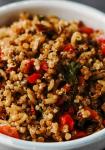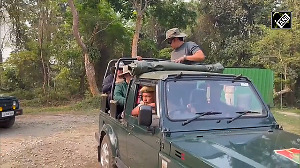US air defences were completely unprepared and faltered during the unprecedented suicide attacks by Osama bin Laden's Al Qaeda network in which hijacked aircraft were crashed into the World Trade Centre and Pentagon on September 11, 2001, said a report released by an independent commission of enquiry on Thursday.
The report said Vice-President Dick Cheney did not issue orders to shoot down hostile aircraft on 9/11 until long after the third and last hijacked airliner had crashed near Pennsylvania and the order was never passed along to military fighter pilots searching for errant aircraft that morning.
A painstaking recreation of the response by military and aviation officials that day also shows that fighter jets never had a chance to intercept any of the three airliners, partly because they had been sent to intercept a plane, American Airlines 11, that had already crashed into the WTC.
The jets also would probably not have been able to stop the last plane, United Airlines Flight 93, from barrelling into the White House or US Capitol if it had not crashed in Pennsylvania, according to the report.
Panel investigators also concluded that authorities with the North American Aerospace Defence Command repeatedly misinformed the commission in testimony last fall about its scrambling of fighters from Langley Air Force Base.
NORAD officials indicated at the time that the jets were responding to either United 93 or American Airlines 77, which struck the Pentagon.
In fact, they were chasing "a phantom aircraft", American 11, which had already struck the Twin Towers, the panel found.
Air defence agencies "were unprepared for the type of attacks launched against the United States on September 11, 2001", the report concludes.
"They struggled, under difficult circumstances, to improvise a homeland defence against an unprecedented challenge they had never encountered and had never trained to meet."
Commission investigators, based on private interviews with both President George W Bush and Cheney and other witnesses, reported that a telephone conversation occurred between the two leaders shortly before 10:10 am or 10:15 am in which Bush authorised Cheney to order jet pilots to shoot down the hostile aircraft.
"We are sure that the nation owes a debt to the passengers of United 93," the report's authors wrote, referring to an apparent insurrection that foiled the hijackers' plans.
"Their actions saved the lives of countless others, and may have saved either the US Capitol or the White House from destruction."
The stark conclusions come as part of the last interim report to be issued by the staff of the National Commission on Terrorist Attacks Upon the United States, which is racing to complete a final book-length report by the end of next month.
The 10-member bipartisan panel will hear its last public testimony from military and aviation officials on Thursday.
The report also documents a succession of mistakes, wrong assumptions and puzzling errors made on the morning of September 11 by air defence and aviation employees, who often did not communicate with each other when they should have and frequently seemed unsure of how to respond to the assault.
The investigators reported that Cheney issued the first shoot-down order a few minutes after talking to Bush, based on reports from the Secret Service of an aircraft -- United 93 -- headed towards Washington. But the reports were based on trajectory estimates; Flight 93 had crashed in Pennsylvania at 10:03 am. The vice-president issued a similar order at around 10:30 am in response to another report of a hijacked plane. "Eventually," the report notes, "the shelter received word that the alleged hijacker five miles away had been a Medevac helicopter."
Cheney's general shoot-down orders were issued to NORAD at 10:31 am, but clear instructions were never passed along to pilots in the air. "In short," the report says, "while leaders in Washington believed the fighters circling above them had been instructed to 'take out' hostile aircraft, the only orders actually conveyed to the Langley pilots were to 'ID type and tail.'
"The Langley pilots were also never told why they were scrambled or that hijacked commercial airliners were a threat," the commission's staff found.






 © 2025
© 2025